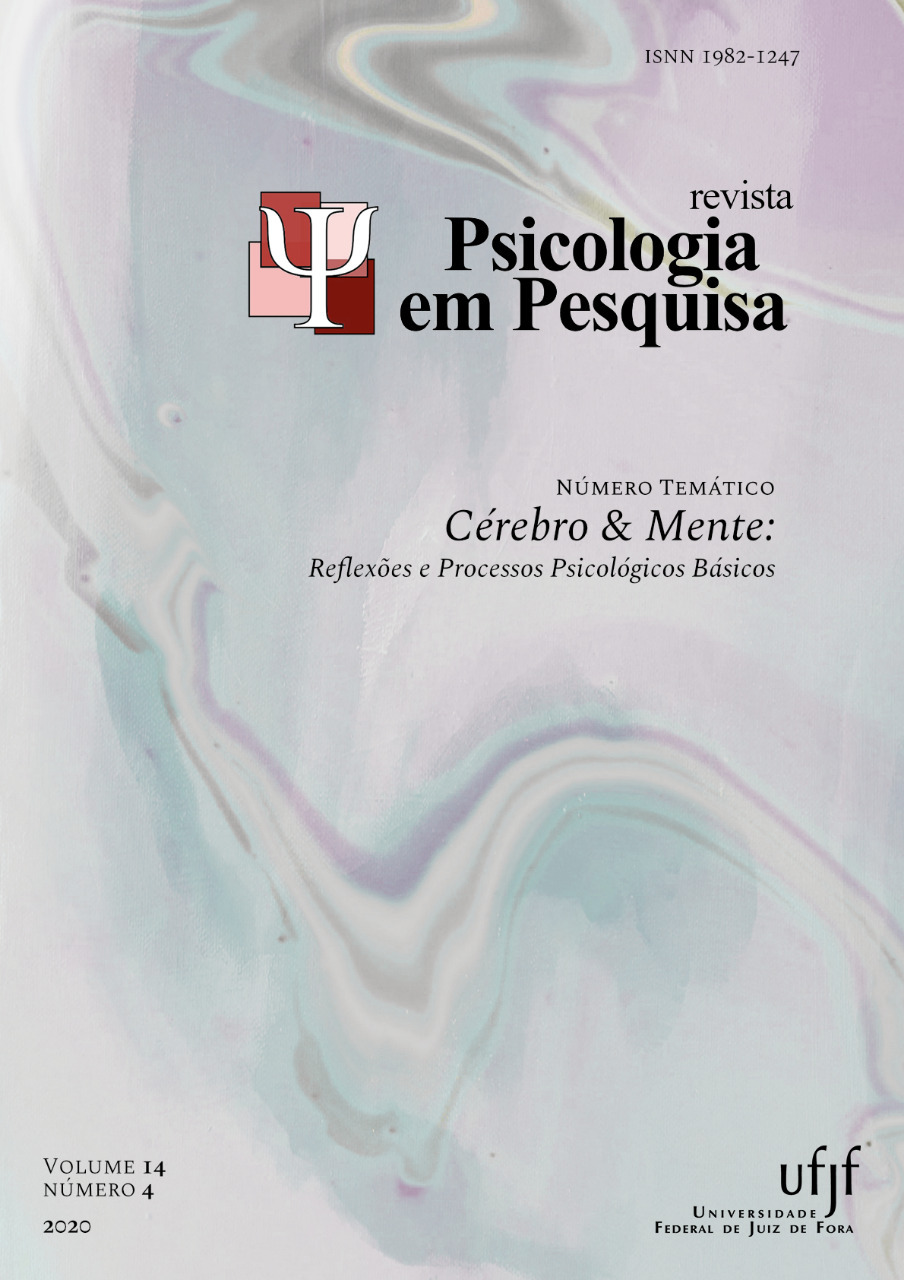Effect of working memory load on tactile n-back task
DOI:
https://doi.org/10.34019/1982-1247.2020.v14.30409Resumo
The present study investigated the characteristics of tactile working memory using the N-Back Task. The participants (n = 16), all sighted, performed the task with working memory loads equivalent to maintaining one, two, or three letters in the working memory (N-Back 1, N-Back 2, and N-Back 3). The frequency of commission and omission errors was analyzed as a function of memory load. The results indicate an increase in the frequency of omission errors due to this factor. The working memory load did not significantly influence commission errors. In general, our results suggest that the tactile N-Back task may represent a promising method for the assessment of working memory in blind and sighted participants.
Downloads
Referências
Baddeley, A. (2012). Working memory: theories, models, and controversies. Annual Review of Psychology, 63, 1-29. doi.org/10.1146/annurev-psych-120710-100422
Bliss, I., & Hämäläinen, H. (2005). Different working memory capacity in normal young adults for visual and tactile letter recognition task. Scandinavian Journal of Psychology, 46(3), 247-251. doi.org/10.1111/j.1467-9450.2005.00454.x
Degenaar, M., & Lokhorst, G. (2017). "Molyneux's Problem", The Stanford Encyclopedia of Philosophy (Winter 2017 Edition), Edward N. Zalta (ed.), URL = <https://plato.stanford.edu/archives/win2017/entries/molyneux-problem/>.
Deibert, E., Kraut, M., Kremen, S., & Hart, J. (1999). Neural pathways in tactile object recognition. Neurology, 52(7), 1413-1413. doi.org/10.1212/WNL.52.7.1413
Fernandes, A. M., & Albuquerque, P. B. (2012). Tactual perception: a review of experimental variables and procedures. Cognitive Processing, 13(4), 285-301. doi.org/10.1007/s10339-012-0443-2
Gallace, A., & Spence, C. (2009). The cognitive and neural correlates of tactile memory. Psychological Bulletin, 135(3), 380. doi.org/10.1037/a0015325
Gibson, J. J. (1962). Observations on active touch. Psychological Review, 69(6), 477- 491. doi.org/10.1037/h0046962
Loomis, J. M., & Lederman, S. J. (1986). Tactual perception. In: K. R. Boff, L. Kaufman & J. P. Thomas (Eds.), Handbook of Perception and Human Performances, Vol. 2 (pp. 31/1–31/41). New York, NY: Wiley.
Loomis, J. M., Klatzky, R. L., & Lederman, S. J. (1991). Similarity of tactual and visual picture recognition with limited field of view. Perception, 20(2), 167-177. doi.org/10.1068/p200167
Meule, A. (2017). Reporting and interpreting working memory performance in n-back tasks. Frontiers in psychology, 8, 352. doi: 10.3389/fpsyg.2017.00352
Masson, H. L., Bulthé, J., De Beeck, H. P. O., & Wallraven, C. (2016). Visual and Haptic Shape Processing in the Human Brain: Unisensory Processing, Multisensory Convergence, and Top-Down Influences. Cerebral Cortex, 26(8), 3402-3412. doi.org/10.1093/cercor/bhv170
Penha, M. R., Garcia, R. B., Douchkin, I. O., & Da Silva, J. A. (2014). Precisão, sensibilidade e confiança na percepção háptica de peso na presença ou ausência de movimento e visão. Estudos de Psicologia, 19(4), 268-277. doi.org/10.1590/S1413294X2014000400004
Picard, D., & Monnier, C. (2009). Short-term memory for spatial configurations in the tactile modality: A comparison with vision. Memory, 17(8), 789-801. doi.org/10.1080/09658210903107838
Ricciardi, E., Bonino, D., Gentili, C., Sani, L., Pietrini, P., & Vecchi, T. (2006). Neural correlates of spatial working memory in humans: a functional magnetic resonance imaging study comparing visual and tactile processes. Neuroscience, 139(1), 339-349. doi.org/10.1016/j.neuroscience.2005.08.045
Sacks, O. (1993). To see and not see. The New Yorker, May 10, 59-73.
Snow, J. C., Strother, L., & Humphreys, G. W. (2014). Haptic shape processing in visual cortex. Journal of Cognitive Neuroscience, 26(5), 1154-1167. doi.org/10.1162/jocn_a_00548
Yaple, Z. A., Stevens, W. D., & Arsalidou, M. (2019). Meta-analyses of the n-back working memory task: fMRI evidence of age-related changes in prefrontal cortex involvement across the adult lifespan. NeuroImage, 196, 16-31. doi.org/10.1016/j.neuroimage.2019.03.074















